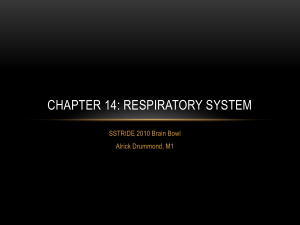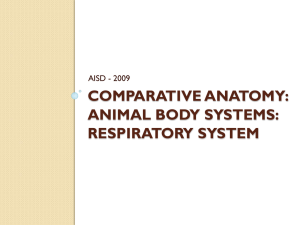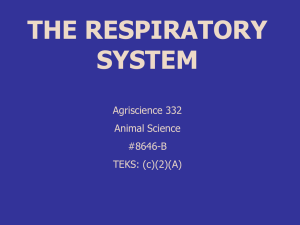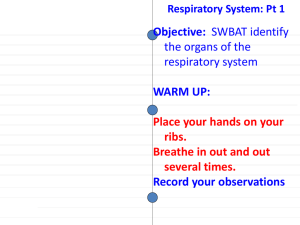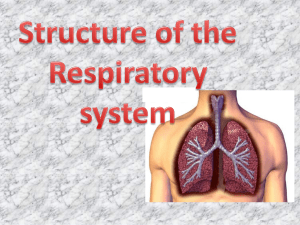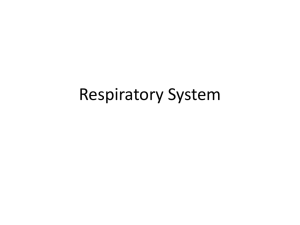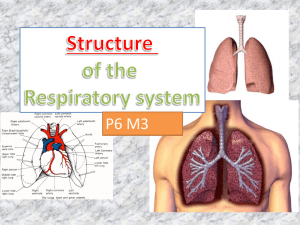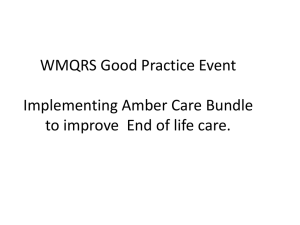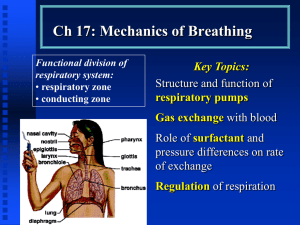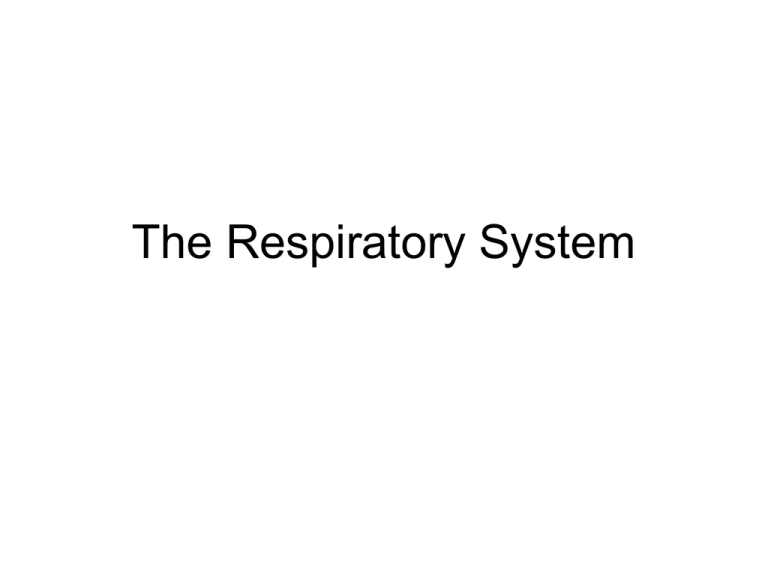
The Respiratory System
Organs of the Respiratory
system
•
•
•
•
•
•
Nose
Pharynx
Larynx
Trachea
Bronchi
Lungs –
alveoli
Figure 13.1
Function of the Respiratory
System
• Oversees gas exchanges between the
blood and external environment
• Exchange of gasses takes place within
the alveoli
• Passageways to the lungs purify, warm,
and humidify the incoming air
The Nose
• The only externally visible part of the
respiratory system
• Air enters the nose through the external
nares (nostrils)
• The interior of the nose consists of a nasal
cavity divided by a nasal septum
Upper Respiratory Tract
Figure 13.2
Anatomy of the Nasal Cavity
• Olfactory receptors are located in the
mucosa on the superior surface
• The rest of the cavity is lined with
respiratory mucosa
– Moistens air
– Traps incoming foreign particles
Anatomy of the Nasal Cavity
• Lateral walls have projections called
conchae
– Increases surface area
– Increases air turbulence within the nasal
cavity
• The nasal cavity is separated from the oral
cavity by the palate
– Anterior hard palate (bone)
– Posterior soft palate (muscle)
Paranasal Sinuses
• Cavities within bones surrounding the
nasal cavity
– Frontal bone
– Sphenoid bone
– Ethmoid bone
– Maxillary bone
Paranasal Sinuses
• Function of the sinuses
– Lighten the skull
– Act as resonance chambers for speech
– Produce mucus that drains into the nasal
cavity Produce mucus that drains into the
nasal cavity
Pharynx (Throat)
• Muscular passage from nasal cavity to
larynx
• Three regions of the pharynx
– Nasopharynx – superior region behind nasal
cavity
– Oropharynx – middle region behind mouth
– Laryngopharynx – inferior region attached to
larynx
• The oropharynx and laryngopharynx are
common passageways for air and food
Structures of the Pharynx
• Auditory tubes enter the nasopharynx
• Tonsils of the pharynx
– Pharyngeal tonsil (adenoids) in the
nasopharynx
– Palatine tonsils in the oropharynx
– Lingual tonsils at the base of the tongue
Larynx (Voice Box)
• Routes air and food into proper channels
• Plays a role in speech
• Made of eight rigid hyaline cartilages and
a spoon-shaped flap of elastic cartilage
(epiglottis)
• Vocal cords - vibrate with expelled air to
create sound (speech)
Structures of the Larynx
• Thyroid cartilage
– Largest hyaline cartilage
– Protrudes anteriorly (Adam’s apple)
• Epiglottis
– Superior opening of the larynx
– Routes food to the larynx and air toward the
trachea
• Glottis – opening between vocal cords
Trachea (Windpipe)
• Connects larynx with bronchi
• Lined with ciliated mucosa
– Beat continuously in the opposite direction of
incoming air
– Expel mucus loaded with dust and other
debris away from lungs
• Walls are reinforced with C-shaped hyaline
cartilage
Primary Bronchi
• Formed by division of the trachea
• Enters the lung at the hilus
(medial depression)
• Right bronchus is wider, shorter,
and straighter than left
• Bronchi subdivide into smaller
and smaller branches
Lungs
• Ocupy most of the thoracic cavity
– Apex is near the clavicle (superior
portion)
– Each lung is divided into lobes by
fissures
• Left lung – two lobes
• Right lung – three lobes
Lungs
Figure 13.4b
Coverings of the Lungs
• Pulmonary (visceral) pleura covers the
lung surface
• Parietal pleura lines the walls of the
thoracic cavity
• Pleural fluid fills the area between layers
of pleura to allow gliding
Respiratory Tree Divisions
•
•
•
•
•
Primary bronchi
Secondary bronchi
Tertiary bronchi
Bronchioli
Terminal bronchioli
Bronchioles
• Smallest
branches of the
bronchi
• All but the
smallest
branches have
reinforcing
cartilage
• Terminal
bronchioles end
in alveoli
Figure 13.5a
Respiratory Zone
• Structures
– Respiratory bronchioli
– Alveolar duct
– Alveoli
• Site of gas exchange
Alveoli
• Structure of alveoli
– Alveolar duct
– Alveolar sac
– Alveolus
• Gas exchange takes place within the
alveoli in the respiratory membrane
• Squamous epithelial lining alveolar walls
• Covered with pulmonary capillaries on
external surfaces
Respiratory Membrane (AirBlood Barrier)
Figure 13.6
Gas Exchange
• Gas crosses the respiratory membrane by
diffusion
– Oxygen enters the blood
– Carbon dioxide enters the alveoli
• Macrophages add protection
• Surfactant coats gas-exposed alveolar
surfaces
Events of Respiration
• Pulmonary ventilation – moving air in and
out of the lungs
• External respiration – gas exchange
between pulmonary blood and alveoli
Events of Respiration
• Respiratory gas transport – transport of
oxygen and carbon dioxide via the
bloodstream
• Internal respiration – gas exchange
between blood and tissue cells in systemic
capillaries
Mechanics of Breathing
(Pulmonary Ventilation)
• Mechanical process
• Depends on volume changes in the
thoracic cavity
• Volume changes lead to pressure
changes, which lead to equalize pressure
of flow of gases
• 2 phases
– Inspiration – flow of air into lung
– Expiration – air leaving lung
Inspiration
• Diaphragm and
intercostal muscles
contract
• The size of the
thoracic cavity
increases
• External air is pulled
into the lungs due to
an increase in
intrapulmonary
volume
Expiration
• Passive process dependent up on natural
lung elasticity
• As muscles relax, air is pushed out of the
lungs
• Forced expiration can occur mostly by
contracting internal intercostal muscles to
depress the rib cage
Expiration
Figure 13.7b
Pressure Differences in the
Thoracic Cavity
• Normal pressure within the pleural space
is always negative (intrapleural pressure)
• Differences in lung and pleural space
pressures keep lungs from collapsing
Nonrespiratory Air Movements
• Caused by reflexes or voluntary actions
• Examples
– Cough and sneeze – clears lungs of debris
– Laughing
– Crying
– Yawn
– Hiccup
Respiratory Volumes and
Capacities
• Normal breathing moves about 500 ml of air with
each breath - tidal volume (TV)
• Many factors that affect respiratory capacity
–
–
–
–
A person’s size
Sex
Age
Physical condition
• Residual volume of air – after exhalation, about
1200 ml of air remains in the lungs
Respiratory Volumes and
Capacities
• Inspiratory reserve volume (IRV)
– Amount of air that can be taken in forcibly
over the tidal volume
– Usually between 2100 and 3200 ml
• Expiratory reserve volume (ERV)
– Amount of air that can be forcibly exhaled
– Approximately 1200 ml
• Residual volume
– Air remaining in lung after expiration
– About 1200 ml
Respiratory Volumes and
Capacities
• Functional volume
– Air that actually
reaches the
respiratory zone
– Usually about 350
ml
• Respiratory capacities
are measured with a
spirometer
Respiratory Sounds
• Sounds are monitored with a stethoscope
• Bronchial sounds – produced by air
rushing through trachea and bronchi
• Vesicular breathing sounds – soft sounds
of air filling alveoli
External Respiration
• Oxygen movement into the blood
– The alveoli always has more oxygen than the
blood
– Oxygen moves by diffusion towards the area
of lower concentration
– Pulmonary capillary blood gains oxygen
External Respiration
• Carbon dioxide movement out of the blood
– Blood returning from tissues has higher
concentrations of carbon dioxide than air in
the alveoli
– Pulmonary capillary blood gives up carbon
dioxide
• Blood leaving the lungs is oxygen-rich and
carbon dioxide-poor
Gas Transport in the Blood
• Oxygen transport in the blood
– Inside red blood cells attached to hemoglobin
(oxyhemoglobin [HbO2])
– A small amount is carried dissolved in the
plasma
• Carbon dioxide transport in the blood
– Most is transported in the plasma as
bicarbonate ion (HCO3–)
– A small amount is carried inside red blood
cells on hemoglobin, but at different binding
sites than those of oxygen
Internal Respiration
• Exchange of gases between blood and
body cells
• An opposite reaction to what occurs in the
lungs
– Carbon dioxide diffuses out of tissue to blood
– Oxygen diffuses from blood into tissue
Internal Respiration
Figure 13.11
Neural Regulation of
Respiration
• Activity of respiratory muscles is transmitted to
the brain by the phrenic and intercostal nerves
• Neural centers that control rate & depth are
located in the medulla
• The pons appears to smooth out respiratory rate
• Normal respiratory rate (eupnea) is 12–15 min.
• Hypernia is increased respiratory rate often due
to extra oxygen needs
Factors Influencing Respiratory
Rate and Depth
• Physical factors
– Increased body temperature
– Exercise
– Talking
– Coughing
• Volition (conscious control)
• Emotional factors
Factors Influencing Respiratory
Rate and Depth
• Chemical factors
– Carbon dioxide levels
• Level of carbon dioxide in the blood is the
main regulatory chemical for respiration
• Increased carbon dioxide increases
respiration
• Changes in carbon dioxide act directly on
the medulla oblongata
Factors Influencing Respiratory
Rate and Depth
• Chemical factors (continued)
– Oxygen levels
• Changes in oxygen concentration in the
blood are detected by chemoreceptors in
the aorta and carotid artery
• Information is sent to the medulla
oblongata
Respiratory Disorders:
Chronic Obstructive Pulmonary Disease
(COPD)
• Exemplified by chronic bronchitis and
emphysema
• Major causes of death and disability in the
United States
• Features of these diseases
– Patients have a history of smoking
– Labored breathing (dyspnea)
– Coughing and frequent pulmonary infections
Respiratory Disorders:
Chronic Obstructive Pulmonary Disease
(COPD)
• Features of these diseases (cont.’)
– Most victims retain carbon dioxide
– Have hypoxic and respiratory acidosis
– Those infected will ultimately develop
respiratory failure
Emphysema
• Alveoli enlarge as adjacent chambers break
through
• Chronic inflammation promotes lung fibrosis
• Airways collapse during expiration
• Patients use a large amount of energy to exhale
• Over-inflation of the lungs leads to a barrel chest
• Cyanosis appears late in the disease
Chronic Bronchitis
• Inflammation of the mucosa of the lower
respiratory passages
• Mucus production increases
• Pooled mucus impairs ventilation & gas
exchange
• Risk of lung infection increases
• Pneumonia is common
• Hypoxia and cyanosis occur early
Lung Cancer
• Accounts for 1/3 of all cancer deaths in the
United States
• Increased incidence associated with
smoking
• Three common types
– Squamous cell carcinoma
– Adenocarcinoma
– Small cell carcinoma
Sudden Infant Death syndrome
(SIDS)
• Healthy infant stops breathing and dies
during sleep
• Some cases are thought to be a problem
of the neural respiratory control center
• 1/3 of cases appear to be due to heart
rhythm abnormalities
Asthma
• Chronic inflammation if the bronchiole
passages
• Response to irritants with dyspnea, coughing,
and wheezing
Developmental Aspects of the
Respiratory System
• Lungs are filled with fluid in the fetus
• Lungs are not fully inflated with air until
two weeks after birth
• Surfactant that lowers alveolar surface
tension is not present until late in fetal
development and may not be present in
premature babies
Developmental Aspects of the
Respiratory System
• Important birth defects
– Cystic fibrosis – over-secretion of thick
mucus clogs the respiratory system
– Cleft palate
Aging Effects
•
•
•
•
Elasticity of lungs decreases
Vital capacity decreases
Blood oxygen levels decrease
Stimulating effects of carbon dioxide
decreases
• More risks of respiratory tract infection
Respiratory Rate Changes
Throughout Life
Respiration rate:
• Newborns – 40 to 80 min.
• Infants – 30 min.
• Age 5 – 25 min.
• Adults – 12 to 18 min
• Rate often increases with old age

